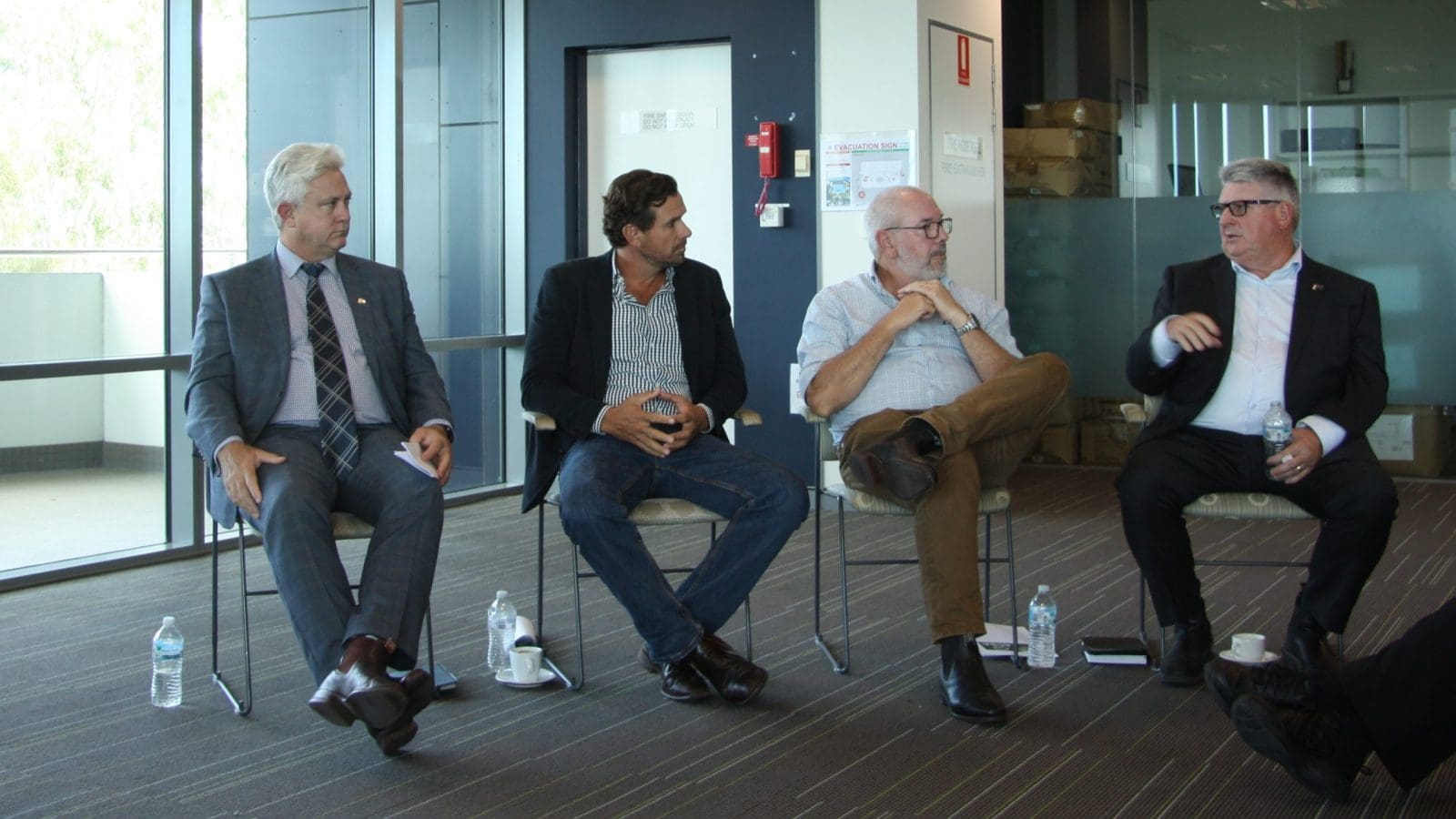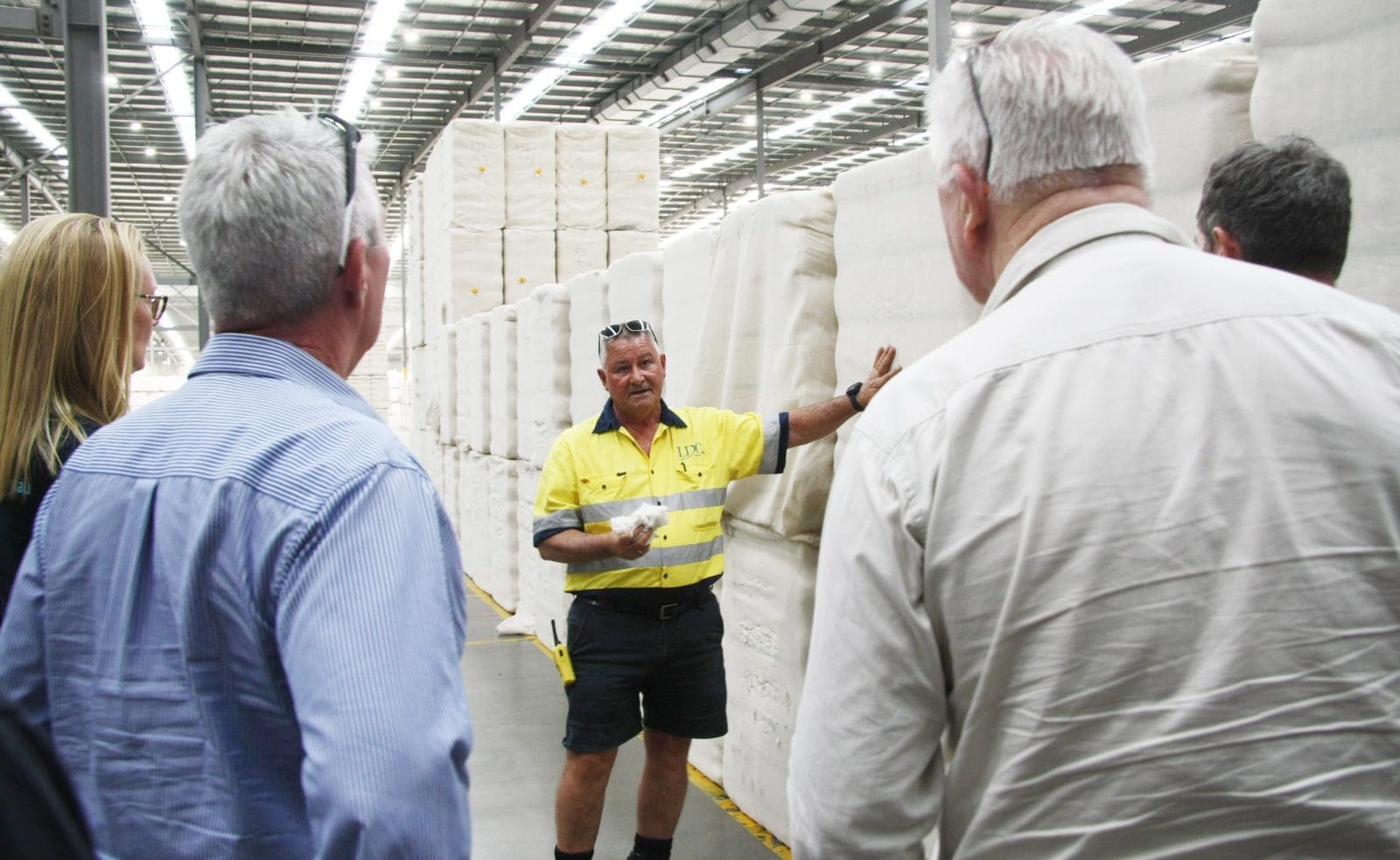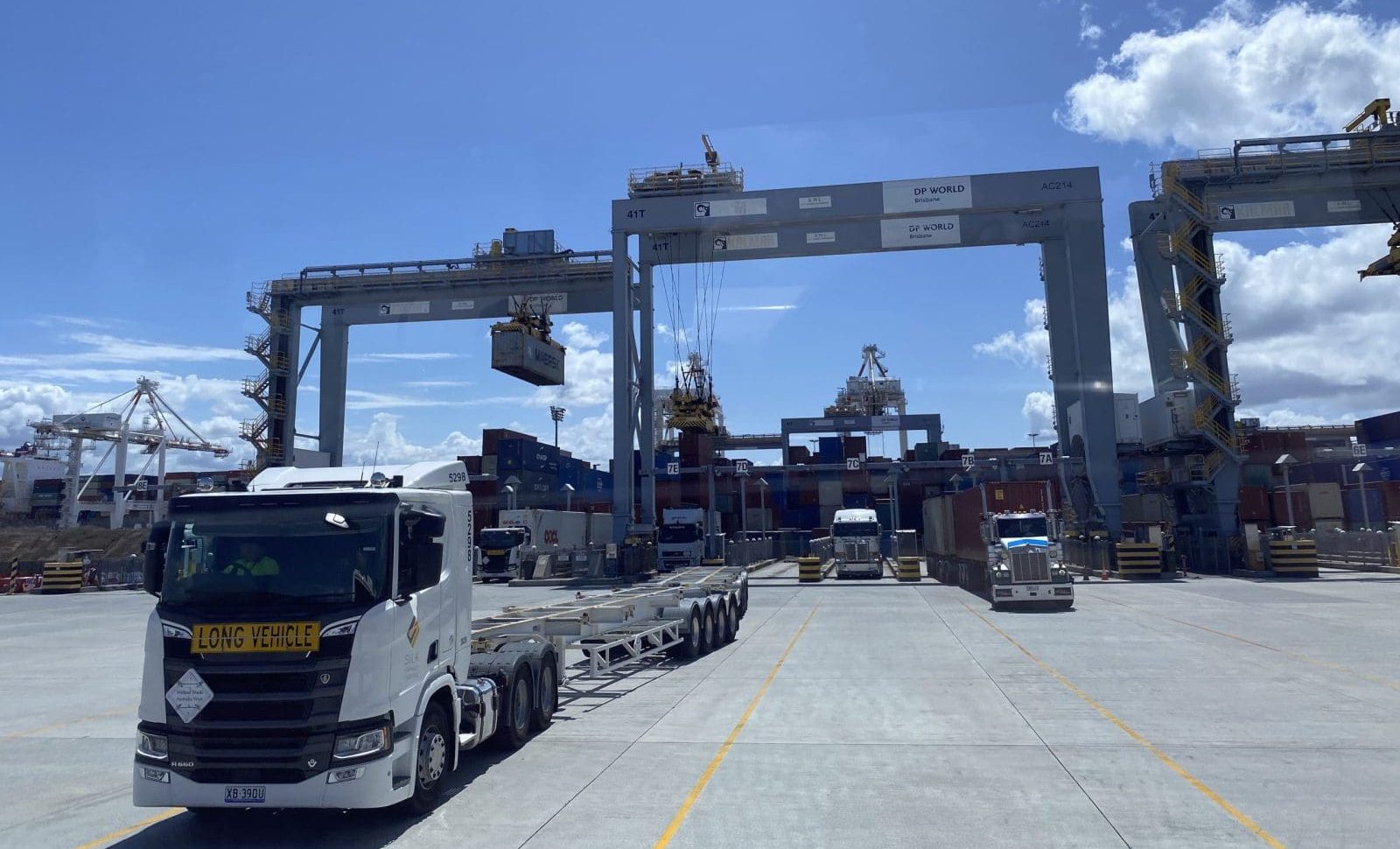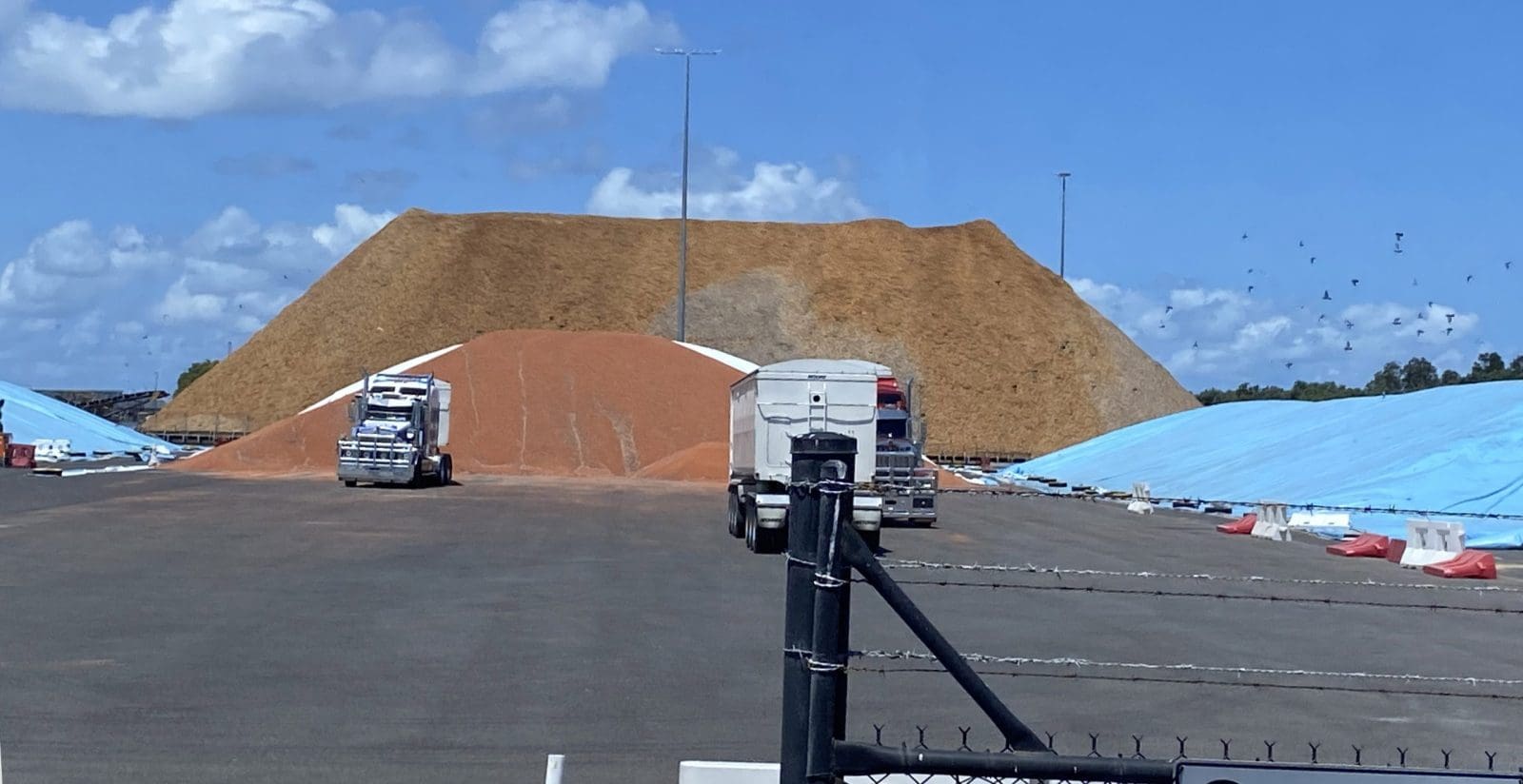
A panel comprising Pulse Australia’s Peter Wilson, ACSA’s Tony Geitz, ACC CEO Anthony Lee, and Qld Department of Primary Industries Director General Graeme Bolton fielded questions at the QTLC showcase at Port of Brisbane on Thursday.
PORT of Brisbane has long been Australia’s biggest beef and cotton exporter, and this year, it has played a key role in exporting Australia’s second-biggest chickpea crop.
Its capabilities, both present and future, were put on show to a group of industry representatives on Thursday as part of the Showcasing Queensland’s Innovative Agricultural Export Supply Chains.
Organised by the Queensland Transport & Logistics Council, it provided insights from specialists in the beef, cotton, and pulses sector, and ended with a port tour that showed the diversity of goods handled, and the interface of road, rail, and sea freight.
Port of Brisbane, which includes GrainCorp’s Fisherman Islands bulk grain terminal and three container-only terminals, handles around half of Qld’s agricultural exports annually.
Port of Brisbane handles around 1.6 million twenty-foot equivalent units (TEU) per annum, well behind Port of Melbourne on 3M and Sydney’s Port Botany on 2.8M.
However, Port of Brisbane’s TEU figure is on a growth trajectory, as services offers expand, and its 224ha Future Port Expansion is developed on a needs basis.
Port of Brisbane senior manager business development Tim Cope outlined the staged expansion, as well as plans to widen and deepen the navigation channel into the Port of Brisbane.
This will shorten the 4-5 hour transit time through Moreton Bay, and allow two-way rather than single-lane traffic for ships up to 350m in length.
“It will allow us to bring in bigger ships on all tides through the channel,” Mr Cope said.
Heavy lifting on chickpeas
Chair of Grains Australia’s Pulse Council and LDC trader Peter Wilson said the Port of Brisbane with its rail and road train access, was significant in getting much of Australia’s second-biggest chickpea crop out ahead of the scheduled return of tariffs in India from April 1.
Its contribution came from its container capacity, and also GrainCorp’s Fisherman Islands bulk grain terminal.
“I think the port did really really well…and the fact that we could get road trains into port was a great help,” Mr Wilson said.
Several rail trains also delivered chickpeas to the GrainCorp terminals.
“We got the crop out and we got it into the hands of the end market.”
Three other bulk terminals on the Brisbane River, but not part of the Port of Brisbane, also contributed, with Qld ports shipping 885,000 tonnes of chickpeas to all destinations in the Oct-Dec quarter out of the national total of 1.3Mt.

Qld Department of Primary Industries Director-General Graeme Bolton, ACC CEO Anthony Lee, and LDC’s Tony Geitz and Peter Wilson, representing the Australian Cotton Shippers Association and Grains Australia respectively all presented at the QTLC showcase and then formed a discussion panel.
Mr Wilson said 74 percent of Australia’s 2024-25 chickpea crop exported to date has been shipped in bulk, with the balance in containers, a complete flip from the record production and export year of 2016-17.
Six eastern Australian bulk ports have exported this season’s chickpeas this season out of 10 berths, four of them in Brisbane.
“We made very very good use of elevation capacity.”
“We were aided and abetted by the very slow export pace of wheat.”
Leader on cotton
LDC’s head of cotton in Australia and past chair of the Australian Cotton Shippers Association Tony Geitz ran through the importance of Port of Brisbane as Australia’s biggest exporter of cotton lint.
Port of Brisbane last season exported 51pc of Australia’s cotton, with Sydney on 32pc, and Melbourne 17pc, and Port of Brisbane’s share of cotton shipments has been as high as 60pc.
“Brisbane Port is a very important port for our industry,” Mr Geitz said, adding that the cotton supply chain was always looking to improve efficiencies in getting bales from gin to port.
“We are now putting bales into a container at the gin as opposed to on to a flatbed because we can get some more efficiencies; we can get more bales in a truck movement.”
He said developments in northern Australia were also welcome.
“The Ord scheme at Kununurra – they’ll produce roughly 100,000 bales there this year, and we’ve got another emerging industry in the Northern Territory.”
Northern Territory lint is currently being shipped out of LDC’s warehouse at Port of Brisbane, although NT and Ord cotton may be shipped out of northern Australia in the future.

LDC Port of Brisbane warehouse manager Brian Bush with some of the last bales from the 2023-24 ginning season.
The QTLC showcase included a visit to LDC’s Port of Brisbane warehouse, where the last bales of 2023-24 cotton are being packed into 40-footers at 110b per container.
The LDC warehouse was also the accumulation point for Australia’s only break-bulk cargo of cotton done in recent decades.
Bright for beef
Port of Brisbane is the departure point for around 70 percent of Australia’s beef exports, including product from the Australian Country Choice facility at nearby Murarrie.
ACC chief executive officer Anthony Lee said the facility employs people from 71 nationalities, all working to put quality product into domestic channels, including Coles and Woolworths, as well as export.
Mr Lee said the growing US market, based on its lowest herd in 70 years, as well as ACC’s ability to tell the paddock-to-plate story of beef from cattle that go through the supply chain together from calving to slaughter, were two of the bright spots.
“It’s a very exciting time to be in the cattle and beef industry.”

DP World cranes receive from, and discharge to, road transport.
Mr Cope said beef was the “high value, high volume” product for the Port of Brisbane, with the value often outstripping bulk exports.
“Most years, it’s our number-one export commodity.”
Port of Brisbane figures include shipment of 73,897 containers of meat in 2024.
On the quayline
The QTLC showcase took visitors on a tour of the quayline, which caters for bulk handling also of coal and woodchip exports, and cement and fertiliser imports.
On the grain front, GrainCorp’s Fisherman Islands facility sits between the bulk handling and other sections of the quay, and has already handled chickpeas and wheat from the winter crop, as focus shifts to sorghum now being harvested in volume across southern Queensland.
The GrainCorp site is fed by road and rail, and is storing grain in bunkers as well as silos after the small 2023-24 harvest meant bunkers were not required in 2024.

Sorghum is coming into GrainCorp’s Fisherman Islands site ahead of bulk export.
DP World’s Brisbane terminal is its first Australian site to become semi-automated, and sits between Patrick Terminals’ Autostrad facility and Hutchison Ports terminal which, like DP World, has automated stacking cranes.
The DP World facility has landside containers arrive via 25 truck bays, which feed five automatic stacking cranes.
Back from the quay and adjacent to the container terminals, as well as the AAT terminal which handles vehicles, machinery, wind turbines, containers, and break bulk, is the adjacent Brisbane Multimodal Terminal, which receives six container trains per week.
Grain Central: Get our free news straight to your inbox – Click here

HAVE YOUR SAY